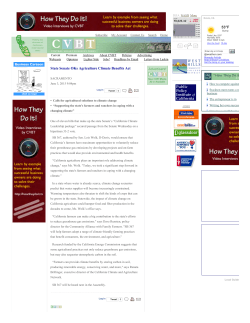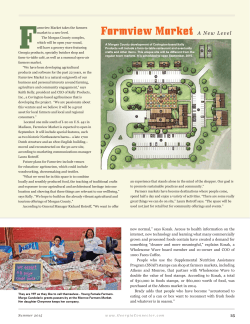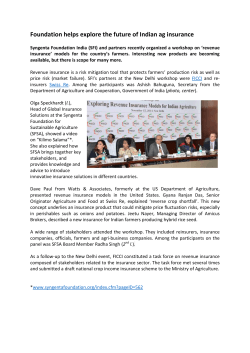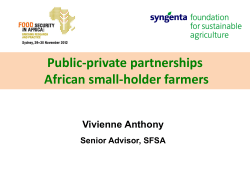
A look: Past, Present & Future
A look: Past, Present & Future Camilo Barrios, Lizeth Llanos, Diego Obando Diana Giraldo d.giraldo@cgiar.org Led by: Supported: Liderado por IFPRI BIOVERSITY ICARDA CIMMYT CIAT CIP AFRICARICE IITA ICRISAT ICRAF ILRI IWMI IRRI WORLDFISH CIFOR Whilst in other regions of the world there are a range of initiatives related to agro-climatic forecasting, there is a big gap in Latin America, which provides a tremendous opportunity for contribution with a targeted and well-integrated initiative to change in agro-climatic risk management, the elaboration of public policies in decision-making and programmatic support (based on historical analysis, monitoring systems and agro-climatic forecasts) using state-of-the-art approaches. Don Luis Fonseca is a dedicated farmer of Maize in the department of Cundinamarca in Colombia. Don Luis said that in the first half of 2013 lost 90% of the expected production by reduction in traditional rainfall. Following this, he and other farmers decided not to try planting in the second half. However, they did not know that weather conditions would be optimal for production in the second half!. Now, Don Luis believes that if he and his fellow farmers have earlier information on the possible climate conditions in your region in the coming months and how their crops might respond to these conditions, would be more successful in their farming. Relationship between annual anomalies (max temp) and rice yield in Colombia 1. learn from the past: Liderado por RClimTool (GUI under R language) was designed with the aim of facilitating users in statistical analysis. Figure 1. RClimTool Modules, has been downloaded 168 times since from all around the world its launch in March 2014. 2. Climate prediction system: CPT Tool Liderado por In Colombia since 2014 was elaborated climate forecasts (1 to 6 months), based on Canonical Correlation Analysis - CCA (Figure 4) using different predictors as sea surface temperatures (SST), among others. Precipitation, maximum and minimum temperatures were used as predictand field with 114 meteorological stations with records from 1980-2013. Select the best planting date, as a preventive measure. Decreased monthly rainfall Increased monthly temperatures and solar radiation If farmers make the decision to plant until June 20, the yield obtained can be around 4500 kg/ha. If the crop sowings are delayed, yields will decrease. "This weather so strange, I don't know which variety to plant" In addition to know when sow, You can also know the best cultivar to sow! If farmers decide to sown after June 15, the best choice will be the variety Fedearroz 733. Fedearroz 733: 6860 kg/ha PS Fedearroz 60: 4600 kg/ha PS Generating new knowledge at the service of farmers Knowledge transfer to extension service of rice producers’ association in Colombia. Knowledge transfer to farmers Next step…AGROCLIMAS Mapping networks: Information flows and decisionmaking cycles understand demand and gaps Historical data: Learn from the past- climate reconstruction, combine observations with satellite data Food Security indicators: household surveys, tracking of climate risk - Grameen Progress out of Poverty Index and gender-sensitive Map Rooms: Web site- regional observatory with agro-climatic data, tailored for specific users and updated Agro-Climatic Forecasts: Provide relevant future informationsentinel site network, combined with local information. Dissemination mechanisms: Innovative “formats” of products, “translating” climate into agronomically relevant information www.ccafs.cgiar.org http://dapa.ciat.cgiar.org/
© Copyright 2025




















